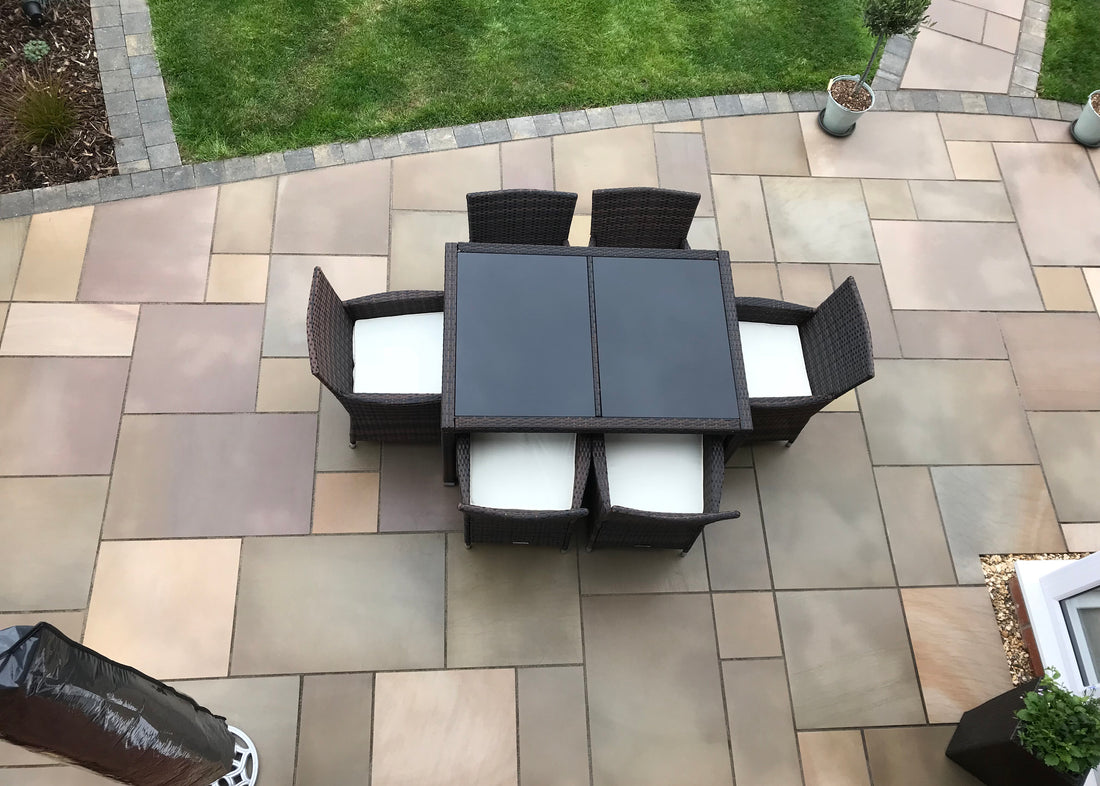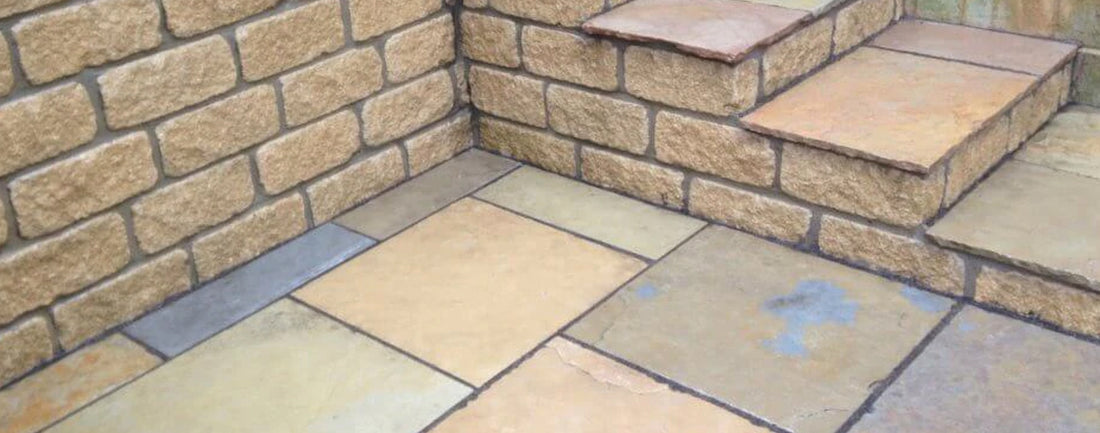Limestone and sandstone are both popular building materials for driveways, patios, and garden projects. But what’s the difference between limestone and sandstone — and which is better?
There are pros and cons to both and it may depend on what you want to get out of your patio.
So let’s jump in and compare the two:
Table of Contents
- Which costs more
- Which is more weather-resistant
- Which is tougher & lasts longer
- Which has the most options
- Which looks better
- Which is easier to include in your designs
- Key takeaways
Limestone versus Sandstone — which is more expensive
Both limestone and sandstone will give you a lot for your money. But if we were to really sit down and do the calculations, you’d probably find that when it comes to Indian stone, limestone would just about edge it over the sandstone, being a few pounds cheaper per square metre.
That’s just a general guidance, however. Prices will vary depending on the types of stone you buy. Kota Black Limestone is one of the most affordable options out there and also extremely popular due to its more neutral colour.
Our Verdict: Limestone edges it but really they’re both winners. There’s too little difference in the price for any meaningful champion.
Which is better suited to the UK weather
Both limestone and sandstone are well-suited to take on the British weather. They don’t absorb a lot of water, so they perform well even in the rainiest parts of the country — such as the Lake District or the Scottish Highlands. They’re both ice and algae-resistant.
However, some of the softer sandstones, such as Mint Fossil Indian sandstone, can be a bit more porous than the denser shades like Kandla Grey. So you might have to give them a little more TLC — but only by a little. An extra clean every now and then or sealant application and you’ll be all set.
Find out how to clean sandstone in our guide here.
We should also mention that all limestone requires sealing anyway. So it’s not like having to seal one of the softer sandstones is really a disadvantage.
Our Verdict: Limestone just about edges it, but only if you’re comparing it with some of the softer sandstones, as it is naturally a little less porous.

Which is tougher and longer-lasting
Both limestone and sandstone will be more than strong enough to deal with cars rolling across them, providing the bed is done correctly, or for plentiful foot traffic.
But if you are looking for the most easily maintained option, limestone is the way to go. For both interior and exterior, limestone is the best paving stone when you want something quick and easy to care for.
Sandstone is generally softer than limestone and other types of rock, so it may be more prone to scratching or denting. For interior use, you might want to avoid this to maintain your flooring for longer. Also, if you have elderly people or children at home, you should probably avoid highly polished sandstone. Although this looks beautiful and classic, it can become slippery, particularly in wet conditions.
Both are really low maintenance but you do need to take some modest care of them. As long as you don’t use salt to de-ice your limestone patios (use sand instead) and clean them every now and then you should be set.
Find out more about the dos and don’ts of limestone and sandstone care here.
Our Verdict: Limestone again marginally edges this one.

Which has the best number of options
Limestone comes in many gorgeous natural colours. Including Kota Blue limestone, Tandur Yellow and Kota Black. You’re bound to find some type of limestone that’ll fit in great with your landscaping ambitions.
However sandstone is even more endowed with so many gorgeous natural variants, such as Autumn Brown, Raj Green, Kandla Grey, Mint Fossil and Cotswold Yellow.
We could recommend checking to see how the stone you choose looks when it is wet. Some look even better after heavy rain, as the colours intensify in the wet, and can even brighten up a space on a gloomy day.
Our Verdict: Due to the extensive range of sandstone colours and styles on the market, we’ll have to give this one to sandstone.
Which looks and feels better
Here limestone and sandstone are quite different. For starters, limestone tends to be flatter and smoother than sandstone. Making it a great interior stone flooring choice. And a great choice for driveways, too.
Limestone also tends to feel a little bit rough (but not in a bad way). With a bit of an orange-peel texture and with a natural split surface. This gives it plenty of grip.
Sandstone has a more uneven layer surface and has a rippled feeling underfoot. But with the honed or shotblast technique it can be made to feel more finely-grained like limestone. Shotblasting has the added benefit of giving sandstone even more grip and slip-resistance underfoot, while the honed finish will lend a smoother and more contemporary look whilst giving a sleek feel to your sandstone.
Our Verdict: Sandstone has more textural choices to choose from. Including smooth and rougher textures. So sandstone edges it over limestone here.


Which is easier to incorporate into your designs
Both limestone and sandstone can be cut and shaped into pieces easily, so neither is expensive to install the way you want them.
Both types of stone are strong, weather-resistant, and come in a wealth of different colours and finishes. They are natural products of the Earth, naturally occurring in seabeds and mountains. So you are pretty much guaranteed to find any type of limestone or sandstone that will look natural and fit into your design ideas.
Sandstone probably edges it if you’re planning on renovating a patio, garden path or indoor living space in any property type — old or new. Simply because there are more options to choose from (see above). You can make gorgeous Indian sandstone circles to act as focal points in a garden, too.
Although, if it’s a sleek, clean look you’re after, sandstone may not be the material for you, unless you’re going for the sawn sandstone. No two slabs of sandstone look the same. But limestone looks very like-for-like from stone to stone, making it suitable for internal and external applications. Especially for driveways, stepping stones, pathways and bathrooms and kitchens inside the home. You can choose a dark black limestone paver and achieve a uniform, clean look, without any concerns of matching stone colours perfectly alongside one another. Limestone may edge it here over sandstone in how it can be applied universally.
Our Verdict: Both limestone and sandstone are fantastic choices for your garden and can be incorporated into your design ideas very well. There’s no clear winner here and as usual it’s more down to preference and use case priorities.

Key Takeaways
- Both limestone and sandstone are great choices, depending on their usage.
- Both are strong, low-maintenance stones that will last for years under heavy foot traffic and vehicles.
- Limestone can be slightly cheaper.
- Sandstone has more options to choose from.
- Limestone is slightly better for some applications, such as in bathrooms, kitchens and interior flooring.
Still got questions about limestone and how it compares to sandstone? Then contact us today. Our specialists will be happy to help.
View our Indian Sandstone paving collection
View our Indian Limestone paving options here
Send us an email or call us — We will respond ASAP!

